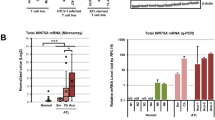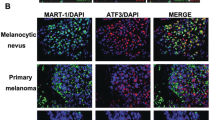Abstract
Melanoma differentiation associated gene-5 (mda-5) was identified by subtraction hybridization as a novel upregulated gene in HO-1 human melanoma cells induced to terminally differentiate by treatment with IFN-β+MEZ. Considering its unique structure, consisting of a caspase recruitment domain (CARD) and an RNA helicase domain, it was hypothesized that mda-5 contributes to apoptosis occurring during terminal differentiation. We have currently examined the expression pattern of mda-5 in normal tissues, during induction of terminal differentiation and after treatment with type I IFNs. In addition, we have defined its genomic structure and chromosomal location. IFN-β, a type I IFN, induces mda-5 expression in a biphasic and dose-dependent manner. Based on its temporal kinetics of induction and lack of requirement for prior protein synthesis mda-5 is an early type I IFN-responsive gene. The level of mda-5 mRNA is in low abundance in normal tissues, whereas expression is induced in a spectrum of normal and cancer cells by IFN-β. Expression of mda-5 by means of a replication incompetent adenovirus, Ad.mda-5, induces apoptosis in HO-1 cells as confirmed by morphologic, biochemical and molecular assays. Additionally, the combination of Ad.mda-5+MEZ further augments apoptosis as observed in Ad.null or uninfected HO-1 cells induced to terminally differentiate by treatment with IFN-β+MEZ. The mda-5 gene is located on human chromosome 2q24 and consists of 16 exons, without pseudogenes, and is conserved in the mouse genome. Present data documents that mda-5 is a novel type I IFN-inducible gene, which may contribute to apoptosis induction during terminal differentiation and during IFN treatment. The conserved genomic and protein structure of mda-5 in human and mouse will permit analysis of the evolution and developmental aspects of this gene.
This is a preview of subscription content, access via your institution
Access options
Subscribe to this journal
Receive 50 print issues and online access
$259.00 per year
only $5.18 per issue
Buy this article
- Purchase on Springer Link
- Instant access to full article PDF
Prices may be subject to local taxes which are calculated during checkout







Similar content being viewed by others
References
Akesson E, Oturai A, Berg J, Fredrikson S, Andersen O, Harbo HF, Laaksonen M, Myhr KM, Nyland HI, Ryder LP, Sandberg-Wollheim M, Sorensen PS, Spurkland A, Svejgaard A, Holmans P, Compston A, Hillert J and Sawcer S . (2002). Genes Immun., 3, 279–285.
Barber GN . (2001). Cell Death Differ., 8, 113–126.
Bernstein E, Caudy AA, Hammond SM and Hannon GJ . (2001). Nature, 409, 363–366.
Bouchier-Hayes L and Martin SJ . (2002). EMBO Rep., 3, 616–621.
Chien G, Yuen PW, Kwong D and Kwong YL . (2001). Cancer Genet. Cytogenet., 126, 63–67.
Darnell Jr JE, Kerr IM and Stark GR . (1994). Science, 264, 1415–1421.
de Veer MJ, Holko M, Frevel M, Walker E, Der S, Paranjape JM, Silverman RH and Williams BR . (2001). J. Leukoc. Biol., 69, 912–920.
Der SD, Yang YL, Weissmann C and Williams BR . (1997). Proc. Natl. Acad. Sci. USA, 94, 3279–3283.
Der SD, Zhou A, Williams BR and Silverman RH . (1998). Proc. Natl. Acad. Sci. USA, 95, 15623–15628.
Du Plessis L, Dietzsch E, Van Gele M, Van Roy N, Van Helden P, Parker MI, Mugwanya DK, De Groot M, Marx MP, Kotze MJ and Speleman F . (1999). Cancer Res., 59, 1877–1883.
Fisher PB and Grant S . (1985). Pharmacol. Therap., 27, 143–166.
Fisher PB, Gopalkrishnan RV, Chada S, Ramesh R, Grimm EA, Rosenfeld MR, Curiel DT and Dent P . (2003). Cancer Biol. Ther., 2, S23–S37.
Fisher PB, Prignoli DR, Hermo Jr H, Weinstein IB and Pestka S . (1985). J. Interferon Res., 5, 11–22.
Friedman RL, Manly SP, McMahon M, Kerr IM and Stark GR . (1984). Cell, 38, 745–755.
Friesen HJ, Stein S and Pestka S . (1981). Methods Enzymol., 78, 430–435.
Fusenig NE, Breitkreutz D, Boukamp P, Tomakidi P and Stark HJ . (1995). Recent Results Cancer Res., 139, 1–19.
Garattini E and Terao M . (2001). Curr. Opin. Pharmacol., 1, 358–363.
Gopalkrishnan RV, Lam EW and Kedinger C . (1998). J. Biol. Chem., 273, 10972–10978.
Gopalkrishnan RV, Roberts T, Tuli S, Kang D, Christiansen KA and Fisher PB . (2000). Oncogene, 19, 4405–4416.
Gorbalenya A and Koonin EV . (1993). Curr. Opin. Struct. Biol., 3, 419–429.
Hofmann K, Bucher P and Tschopp J . (1997). Trends Biochem. Sci., 22, 155–156.
Holmes M, Rosenberg E and Valerie K . (2003). Methods in Molecular Biology, Vol. 234, Deb S and Deb SP (eds). Humana Press Inc: Totawa, NJ, pp. 1–16.
Huang F, Adelman J, Jiang H, Goldstein NI and Fisher PB . (1999a). Gene, 236, 125–131.
Huang F, Adelman J, Jiang H, Goldstein NI and Fisher PB . (1999b). Oncogene, 18, 3546–3552.
Jackson DP, Watling D, Rogers NC, Banks RE, Kerr IM, Selby PJ and Patel PM . (2003). Melanoma Res., 13, 219–229.
Jagus R, Joshi B and Barber GN . (1999). Int. J. Biochem. Cell Biol., 31, 123–138.
Jankowsky E and Jankowsky A . (2000). Nucleic Acids Res., 28, 333–334.
Jia SF, An T, Worth L and Kleinerman ES . (1999). J. Interferon Cytokine Res., 19, 617–624.
Jiang H and Fisher PB . (1993). Mol. Cell. Differ., 1, 285–299.
Jiang H, Kang DC, Alexandre D and Fisher PB . (2000). Proc. Natl. Acad. Sci. USA, 97, 12684–12689.
Jiang H, Lin J and Fisher PB . (1994). Mol. Cell. Differ., 2, 22139.
Jiang H, Lin J, Su ZZ, Herlyn M, Kerbel RS, Weissman BE, Welch DR and Fisher PB . (1995). Oncogene, 10, 1855–1864.
Jiang H, Su Z-Z, Boyd J and Fisher PB . (1993). Mol. Cell. Differ., 1, 41–66.
Jiang H, Su ZZ, Lin JJ, Goldstein NI, Young CS and Fisher PB . (1996). Proc. Natl. Acad. Sci. USA, 93, 9160–9165.
Kang D, Jiang H, Wu Q, Pestka S and Fisher PB . (2001). Gene, 267, 233–242.
Kang DC, Gopalkrishnan RV, Wu Q, Jankowsky E, Pyle AM and Fisher PB . (2002). Proc. Natl. Acad. Sci. USA, 99, 637–642.
Kovacsovics M, Martinon F, Micheau O, Bodmer JL, Hofmann K and Tschopp J . (2002). Curr. Biol., 12, 838–843.
Kumon K, Kobayashi H, Namiki T, Tsunematsu Y, Miyauchi J, Kikuta A, Horikoshi Y, Komada Y, Hatae Y, Eguchi H and Kaneko Y . (2001). Jpn. J. Cancer Res., 92, 854–862.
Lebedeva IV, Su ZZ, Chang Y, Kitada S, Reed JC and Fisher PB . (2002). Oncogene, 21, 708–718.
Leszczyniecka M, Kang DC, Sarkar D, Su ZZ, Holmes M, Valerie K and Fisher PB . (2002). Proc. Natl. Acad. Sci. USA, 99, 16636–16641.
Leszczyniecka M, Roberts T, Dent P, Grant S and Fisher PB . (2001). Pharmacol. Ther., 90, 105–156.
Leszczyniecka M, Su ZZ, Kang DC, Sarkar D and Fisher PB . (2003). Gene, 316, 143–156.
Levy DE, Marie I, Smith E and Prakash A . (2002). J. Interferon Cytokine Res., 22, 87–93.
Lin JJ, Jiang H and Fisher PB . (1998). Gene, 207, 105–110.
Lindner DJ, Hofmann ER, Karra S and Kalvakolanu DV . (2000). Biochim. Biophys. Acta, 1496, 196–206.
Lotem J and Sachs L . (2002). Oncogene, 21, 3284–3294.
Lovat PE, Irving H, Annicchiarico-Petruzzelli M, Bernassola F, Malcolm AJ, Pearson AD, Melino G and Redfern CP . (1997). Eur. J. Cancer, 33, 2075–2080.
Luking A, Stahl U and Schmidt U . (1998). Crit. Rev. Biochem. Mol. Biol., 33, 259–296.
Lutfalla G, Holland SJ, Cinato E, Monneron D, Reboul J, Rogers NC, Smith JM, Stark GR, Gardiner K and Mogensen KE et al. (1995). EMBO J., 14, 5100–5108.
McKendry R, John J, Flavell D, Muller M, Kerr IM and Stark GR . (1991). Proc. Natl. Acad. Sci. USA, 88, 11455–11459.
Packer RJ, Kramer ED and Ryan JA . (1991). Neurol. Clin., 9, 405–422.
Pellegrini S, John J, Shearer M, Kerr IM and Stark GR . (1989). Mol. Cell. Biol., 9, 4605–4612.
Peng Z, Zhang F, Zhou C, Qiu G, Bai S, Liu W and He L . (2002). Zhonghua. Wai. Ke. Za. Zhi., 40, 776–779.
Pestka S . (1997). Semin. Oncol., 24, S9-18–S9-40.
Pestka S . (2000). Biopolymers (Peptide Sciences), Vol. 55. John Wiley & Sons, Inc.: New York, pp. 254–287.
Pestka S, Langer JA, Zoon KC and Samuel CE . (1987). Annu. Rev. Biochem., 56, 727–777.
Petersen OW, Ronnov-Jessen L, Weaver VM and Bissell MJ . (1998). Adv. Cancer Res., 75, 135–161.
Raffray M and Cohen GM . (1997). Pharmacol. Ther., 75, 153–177.
Samuel CE . (2001). Clin. Microbiol. Rev., 14, 778–809.
Sangfelt SH and Strander H . (2001). Med. Oncol., 18, 3–14.
Saunders LR and Barber GN . (2003). FASEB J., 17, 961–983.
Scott RE . (1997). Pharmacol. Ther., 73, 51–65.
Stark GR, Kerr IM, Williams BR, Silverman RH and Schreiber RD . (1998). Annu. Rev. Biochem., 67, 227–264.
Su Z, Lebedeva IV, Gopalkrishnan RV, Goldstein NI, Stein CA, Reed JC, Dent P and Fisher PB . (2001). Proc. Natl. Acad. Sci. USA, 98, 10332–10337.
Su ZZ, Madireddi MT, Lin JJ, Young CS, Kitada S, Reed JC, Goldstein NI and Fisher PB . (1998). Proc. Natl. Acad. Sci. USA, 95, 14400–14405.
Tanabe T, Kominsky SL, Subramaniam PS, Johnson HM and Torres BA . (2000). J. NeuroOncol., 48, 225–232.
Tapper J, Sarantaus L, Vahteristo P, Nevanlinna H, Hemmer S, Seppala M, Knuutila S and Butzow R . (1998). Cancer Res., 58, 2715–2719.
Toida M, Balazs M, Mori T, Ishimaru JI, Ichihara H, Fujitsuka H, Hyodo I, Yokoyama K, Tatematsu N and Adany R . (2001). Cancer Genet. Cytogenet., 127, 34–37.
Wang Q and Floyd-Smith G . (1998). Gene, 222, 83–90.
Wang ZY and Chen Z . (2000). Lancet Oncol., 1, 101–106.
Will CL, Urlaub H, Achsel T, Gentzel M, Wilm M and Luhrmann R . (2002). EMBO J., 21, 4978–4988.
Yeatman TJ, Cher ML, Mao W, Wloch M and Tedesco T . (1996). Clin. Exp. Metast., 14, 246–252.
Zhang JW, Wang JY, Chen SJ and Chen Z . (2000). J. Biosci., 25, 275–284.
Zhou A, Paranjape J, Brown TL, Nie H, Naik S, Dong B, Chang A, Trapp B, Fairchild R, Colmenares C and Silverman RH . (1997). EMBO J., 16, 6355–6363.
Acknowledgements
The present research was supported in part by National Cancer Institute Grants CA35675, CA97318 and CA98712, the Samuel Waxman Cancer Research Foundation and the Michael and Stella Chernow Endowment. We thank Dr George Stark for providing cell lines. PB Fisher is the Michael and Stella Chernow Urological Cancer Research Scientist in the Departments of Pathology and Urology.
Author information
Authors and Affiliations
Corresponding author
Rights and permissions
About this article
Cite this article
Kang, Dc., Gopalkrishnan, R., Lin, L. et al. Expression analysis and genomic characterization of human melanoma differentiation associated gene-5, mda-5: a novel type I interferon-responsive apoptosis-inducing gene. Oncogene 23, 1789–1800 (2004). https://doi.org/10.1038/sj.onc.1207300
Received:
Revised:
Accepted:
Published:
Issue Date:
DOI: https://doi.org/10.1038/sj.onc.1207300
Keywords
This article is cited by
-
Global trends in research of melanoma differentiation-associated gene 5: a bibliometric analysis from 2002 to 2022
Clinical Rheumatology (2024)
-
Understanding nucleic acid sensing and its therapeutic applications
Experimental & Molecular Medicine (2023)
-
Modulation of innate immune response to viruses including SARS-CoV-2 by progesterone
Signal Transduction and Targeted Therapy (2022)
-
Pattern recognition receptors in zebrafish provide functional and evolutionary insight into innate immune signaling pathways
Cellular & Molecular Immunology (2017)
-
Duck MDA5 functions in innate immunity against H5N1 highly pathogenic avian influenza virus infections
Veterinary Research (2014)



